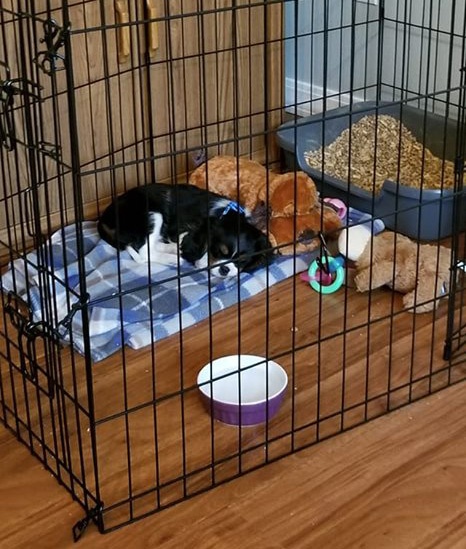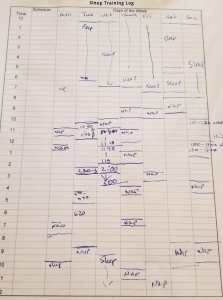Bringing up Puppy! Schedules & Potty Training
Join us in this series, where we follow in the footsteps of our lead trainer and owner Linda Brennen, as she gets her new puppy and experiences all the challenges and joys of adding a new puppy to the family.
Each day we will be sharing videos, pictures and blog posts that includes great tips for all new puppy owners – follow us on Facebook and on Instagram to get daily updates, or check back here daily.
As you will find out, getting a new puppy can be a challenge… even for trainers!
View the entire series at HERE
Setting a Schedule
Developing a schedule with your puppy is key, and it is something we continue to work on. The first couple of weeks is gathering information from puppy to develop a schedule that will work for all of us. We are writing everything down so we can get familiar with his needs, then we can schedule our day around what works best for him. This first week we are focusing on sleep and napping schedules. Here is an example of my current log – this is the “gathering” stage:
He is sleeping very well at night. Puppies tend to go the bed with the sun and right now that is 7:00 pm. One thing I recommend to clients, and we are doing this for puppy, is letting him take a nap at about 7:00 pm, then making a point of waking him up and playing with him until bedtime at about 10:00 pm. If we exercise and play with him in the evening he is sleeping until 7:00 am – it took just 2 nights for it to work.
Making sure your puppy is comfortable goes a long way to help them sleep as well. The first few nights in their new home puppies are exhausted due to the stress of all the changes they are experiencing, so they are not going to be on a set schedule; they sleep a lot! We have noticed he is slowly sleeping much less and becoming more active.
Potty Training

The litter box is in the back of his pen and is being used temporarily as puppy gets used to his new home.
As mentioned on day one, the breeder had introduced the pups to a litter box for potty training. Since he was nine weeks old, he was not fully vaccinated so we were relieved that we didn’t need to put him on the ground for potty breaks during the trip home.
TIP: Most of the canine diseases that we vaccinate our puppies for can be transmitted through exposure to contaminated objects. Viruses, especially the Parvo virus, can persist in contaminated soil for weeks to months. So, until your pup is fully vaccinated, at about 4 months, it is important to avoid areas frequented by unknown dogs, such as rest areas and dog parks.)
During his first week with us we had only one potty accident, and that was on the first morning in our hotel. Once home, we have started transitioning to going outside during the day when it’s warm and using the litter box only occasionally (mostly at night or during the snowstorm we just had!)
I recommend to my clients give their puppies potty breaks during the night on a set schedule. We were surprised that our pup seemed to be able to sleep through the night (7-8 hours) right from the start. He has only needed a potty break at night on the few nights we forgot to make sure he was completely empty before putting him to bed. It may take a few days to figure what is best for your puppy, but remember that each puppy is different. I find males easier to potty train (needing fewer potty breaks), so since he is a male, he seems to be following that trend.
Check back tomorrow as we discuss the challenges we have faced with puppy proofing the house (especially for a smaller puppy!), and how to redirect behavior to toys!
View the entire series at HERE!

